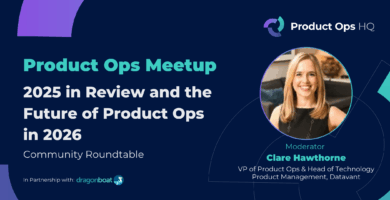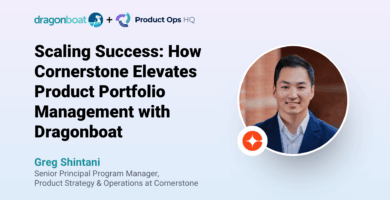Events • On Demand | Watch Time: 55 Min
Defining Success with PMO Professionals – A Fireside Chat
The Program Management Office (PMO) function exists to help product organizations achieve the best portfolio outcomes. The PMO plays an essential role in aligning strategy and execution with business goals to drive outcome-focused product organizations forward from planning, resourcing, managing portfolio dependencies, and executive reporting.
This fireside chat is hosted by the GM of Partner Success at Dragonboat, Bill Cushard. It features Zemira Lalic, Director of Program Management at Bushel, Cedric Roy, Director of Product at Broadsign, and Alexandre Diallo, Senior Technical Project Manager at Chatmeter. Watch and listen in as they discuss program and portfolio management’s evolving role and responsibilities.
This Webinar Covers:
- Demystifying the PMO roles and responsibilities
- The process of each PMO’s role in aligning OKRs
- Negotiating and planning roadmap dependencies and resources
- Transitioning from product management to product portfolio management
Meet the Speakers
Cedric Roy is the Director of Product at Broadsign. He has more than 15 years of experience in software development. He brings his Agile experience to the product organization to help build strategy and great products using data-driven decisions.
Zemira Lalic is a Director of Program Manager at Bushel, overseeing FinTech products delivery. Zemira has 20+ years of experience in the technology industry, driving strategic alignment of business objectives across enterprises while managing multiple portfolios of initiatives from discovery through launch.
Alexandre Diallo is a Senior Technical Project Manager at Chatmeter where he leverages his background in Business Development and Information Technology Management to provide the product team with an effective execution framework to deliver high-quality products with a predictable cadence.
Bill Cushard is the General Manager of Partner Success at Dragonboat helping Chief Product Officers (CPOs) and their teams make the best product decisions across the portfolio to deliver customer value and business outcomes.
Demystifying the PMO Roles: Program Management, Product Management, Project Management
As more companies switch to becoming product-led, new and existing roles within the product organization continue to grow and evolve. But what do each of these roles do? How do they come together to complete the product organization and ensure the team creates products that customers love while driving outcomes?
Within a product organization, Product Manager, Project Manager, and Program Manager are three PMO roles that can be easily confused. Before we dive into where each of these roles fits within the product organization and how they contribute to the overall product strategy, involvement in quarterly planning, and goal alignment, let’s first briefly define the key responsibilities, similarities, and differences.
- Product Manager: While the exact responsibilities vary slightly from company to company, product management is a strategic function at its core. Product Managers are responsible for the development and success of products within their organization and are involved with the entire life cycle of a product. Product Managers develop the long-term strategic direction and product vision by looking at business goals, market research, and available resources to realize that vision. They’re also the people communicating product objectives and roadmaps to the rest of the company and ensuring cross-functional teams are working towards shared organizational goals.
- Program Manager: To understand the Program Manager role, we need to define the meaning of “program.” Programs are composed of several projects that often interconnect to achieve a larger, more long-term business objective. A Program Manager oversees and coordinates all projects, products, and strategic initiatives across the organization. A Program Manager often takes a high-level view of the entire program and guides Project Managers to ensure they work effectively toward their objectives.
- Project Manager: A Project Manager is involved in day-to-day operations, including planning, execution, and delivery. They are responsible for the entire project scope, including a budget, timelines, and resources that will determine the success of the project. While there are similar overlaps with the responsibilities of a Program Manager, a key difference is that a Program Manager often sits at a higher strategic level, and a Project Manager has more tactical responsibilities.
The Project Manager’s responsibilities end once a project is delivered and it’s time to go to market. Whether it’s sales or retention depending on the goal, the outcome is where it moves over to the program.
Alex Diallo, Chatmeter
Some organizations will also have a product operations function with different responsibilities from the three roles above, which also works directly with those teams to drive business goals forward. Product Operations sit at the intersection of product, engineering, and customer success and supports go-to-market teams while improving alignment, communication, and optimizing team processes. The role shares similarities and overlaps with the traditional Program Manager role.
Product Ops, for example, may pull data from existing tools, be involved in product discovery, build dashboards to measure the impact of work, and standardize workflows across the entire product team. However, they are less involved with product build and delivery day-to-day.
What is the Role of Each PMO in Aligning OKRs?
Now that we have an understanding of each of the roles and their key functions, our PMO Pros shared their process of OKR setting and how Product Managers, Project Managers, and Program Managers contribute to goal alignment.
At the executive level, OKRs are set. For example, the executive team at an organization might develop a company-wide annual objective to increase revenue by 5%.
At this stage, Product Managers (often with a VP or Head of Product) will break down the goal into various initiatives to determine what needs to be accomplished and the investment it will take throughout the year (i.e., should we focus on reducing churn rates or increasing MRR?). They’ll make trade-off decisions to ensure the team focuses on the most impactful ways to reach the goal.
Quarterly and continuous planning are used to measure the progress of the initiatives against those goals and make adjustments as needed.
Product Managers typically think about the long-term vision and roadmap for multiple quarters or years out, Program Managers focus on the immediate quarter and how to plan resources, estimate feasibility, manage dependencies and ensure delivery.
The responsibilities can vary between organizations. For example, in some organizations, the engineering team may take on traditional project management while Product Managers focus on the product, deciding what to build. Lastly, Project Managers stay focused on execution, managing all the pieces across the delivery of a product.
Mixed in throughout these roles are validation and research, which are critical pieces of the product puzzle. Sometimes teams will adjust the trajectory based on user feedback, integration feasibility, or available resources.
How Does Feasibility Play Into The Role of PMO?
While the product team will ultimately decide what to build, the Project Manager’s responsibility is to assess the feasibility, determine how long it will take to achieve the goal, and understand the required resources.
Using estimates and looking at the available resources can help show the bigger picture that rolls up into the final decisions of whether the team should focus on feature A or feature B.
“Using a scoring system like RICE, you can understand the value of a feature or project against the effort to determine what to focus on. At Chatmeter, we use RICE scoring to understand if a product is valuable. But if it’s going to take 100% of our resources for three months, maybe it’s not the first thing to focus on this quarter”Alex Diallo, Chatmeter
Feasibility implies whether a company will build a new product or feature, and estimating defines how a company will do it and when. A T-shirt size estimation can assess the risk when a product team has an idea. As planning approaches, this estimating method can be iterated upon and refined. Using a scoring system helps determine how to generate the biggest impact on the most customers with the smallest burden on resources. Product Managers can then prioritize the roadmap based on this data.
“In the beginning when its an idea, we give a gross, t-shirt size estimate, but the more we go into the delivery mode, the more we can iterate and make better estimates.”Cedric Roy, Broadsign
Planning and Managing Dependencies and Resources
When it comes to managing dependencies and resources, first, the product team decides what to build. Next, a Program or Project Manager assesses the feasibility and estimates how and when the outcome will be achieved.
Every quarter (or more frequently if you practice Continuous Planning) there is a planning session to understand the priority of the features the Product Manager wants to approach this upcoming quarter. They need to understand what it takes technically to build it by working with engineering to understand how complex it is. At the end of this planning, they will know how big these items are and then have those conversations and alignment with the reasons to back it up.
“As a Program Manager looking across the entire portfolio to understand what needs to be executed, the next step after the product team has decided what to build and focus on is to figure out what’s necessary to achieve this.”Zemira Lalic, Bushel
One example of how to do this looking at Chatmeter. Alex shared that he and his team use buckets to allocate a percentage of engineering resources (i.e., 75% of engineering resources are for this feature, 10% for infrastructure, and 15% for maintenance).
How Do You Communicate With Your Team When Allocating Resources?
It is a product leader’s responsibility to make the best-informed decisions on resources. However, with limited resources to deliver a million things, how can product leaders draw the line when making allocation decisions?
That’s when portfolio management and allocation come into play. Look at the available resources and have the necessary additional conversations to discuss how to shuffle resources that are used across the wider product organization to achieve the desired goals.
It comes down to proving the “why” in the decision-making process and the context.
“When drawing the line with allocating resources, it comes down to Dragonboat to provide that clarity because you need to explain why you are drawing that line and show all the other things going on. There are only a certain number of things you can deliver before you reach capacity. This opens the door to talk about what is possible and what is not. It’s about communicating what you can give in a meaningful way.”
Alex Diallo, Chatmeter
In Dragonboat, Alex typically starts with the portfolio board to see the capacity for the quarter, totals for each team, and if they are already over or under-allocated. He takes a look at the resource allocation as a visual tool to see the exact percentage. This is where the resource allocation can guide conversations (i.e., Do we need 10% on infrastructure? Can we go down to 7%?)
Using Dragonboat to Bring Everyone Together
Chatmeter started using Dragonboat for the roadmap aspect. They tried different tools, and it was tough to manage. However, once they found Dragonboat and realized it was a fit, they expanded it to the entire team where each team had a distinct area.
The product and engineering team use the roadmapping module for quarterly planning. Executives are able to check progress in real-time. The sales and marketing team can look to the dashboard summary to understand what’s being built and when. With Dragonboat, Chatmeter has one tool to keep everything in one place.
At Broadsign, Cedric and his team use the 3D Roadmap and break things down by team so that it’s easy for everyone to drill in and see the Epics. From there, they share the context with marketing, sales, and customer support.
“We went with Dragonboat to have one platform for our roadmap in the same format for everyone. We can easily share it across the company, and make the presentations needed for various teams and stakeholders.”
Cedric Roy, Broadsign
Final Advice from PMO Pros on Transitioning to Product Portfolio Management
When it came to advising on transitioning from product to portfolio management, the panel had a few tips to give:
Zemira looks back at her experience jumping from product to program portfolio management:
“Think of yourself as a leader and think about what product needs to achieve. In other words, how can you be of value to them? I think of Product Managers as my primary stakeholder. When they’re thinking about planning, I’m thinking about how to get it done.”
Alex doubles down on the open-minded aspect and communication:
“Miscommunication or lack of communication will affect delivery and prevent efficient cross-functional work. There is no such thing as overcommunication when the effort is so cross-functional. Especially in the era of Covid and remote work, utilize the tools you need, be it with slack, email, Dragonboat, etc.”
Cedric’s advice surrounds finding the alignment:
“Take time when you’re doing your planning to look at each of the features on your roadmap to understand how it lines up with your objectives. Does it contribute at all? If there turns out to be features on your roadmap that don’t roll up, then it is time to have a conversation with your manager. All your work needs to be aligned from the bottom-up and vice-versa.”

Featured Speakers

Cedric Roy
Dir of Product, Broadsign
Cedric Roy is the Director of Product at Broadsign. He has more than 15 years of experience in software development. He brings his Agile experience to the product organization to help build strategy and great products using data-driven decisions.

Zemira Lalic
Dir Of Prog MGMT, Bushel
Zemira Lalic is a Director of Program Manager at Bushel, overseeing FinTech products delivery. Zemira has 20+ years of experience in the technology industry, driving strategic alignment of business objectives across enterprises while managing multiple portfolios of initiatives from discovery through launch.

Alexandre Diallo
Sr. Technical Project Manager, Chatmeter
Alexandre Diallo is a Senior Technical Project Manager at Chatmeter where he leverages his background in Business Development and Information Technology Management to provide the product team with an effective execution framework to deliver high-quality products with a predictable cadence.


